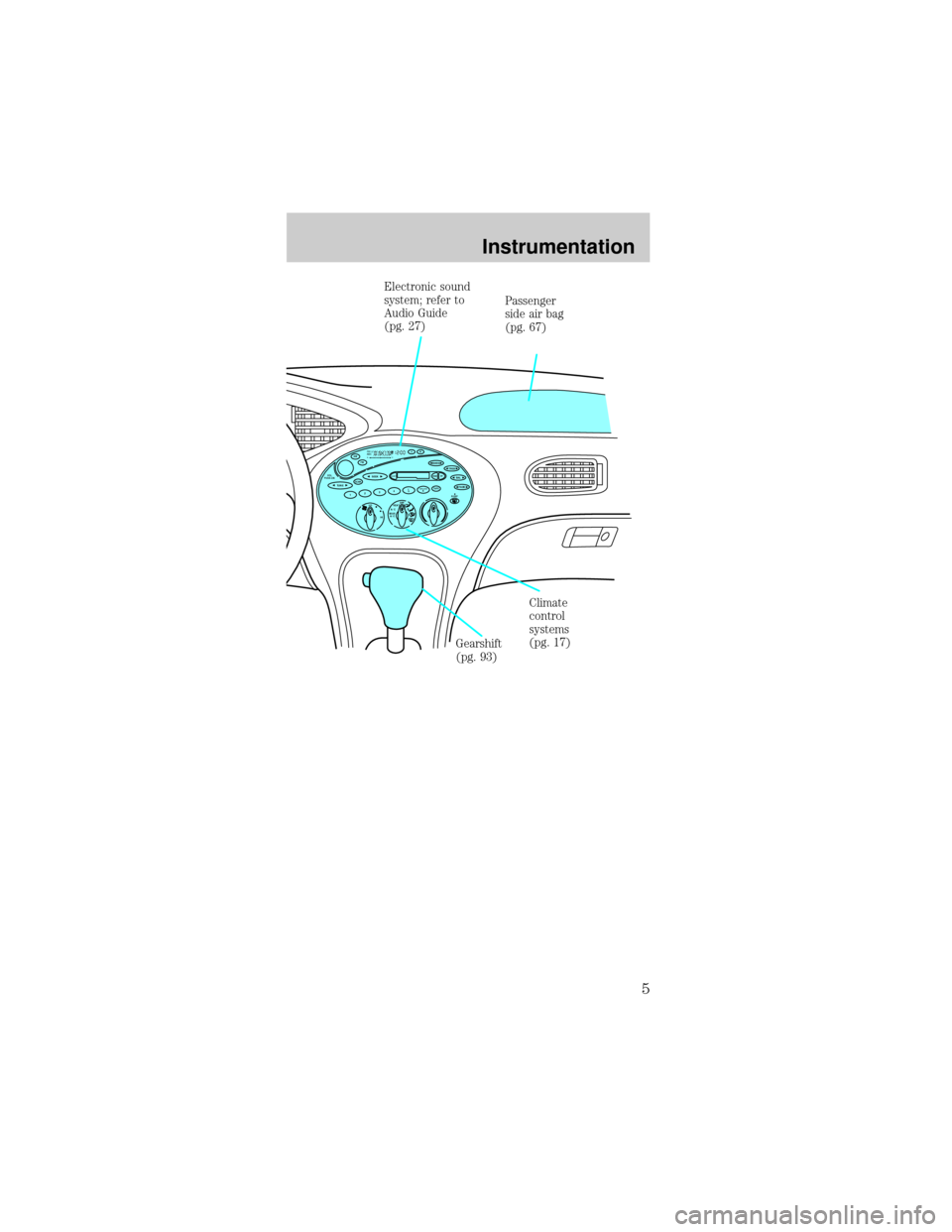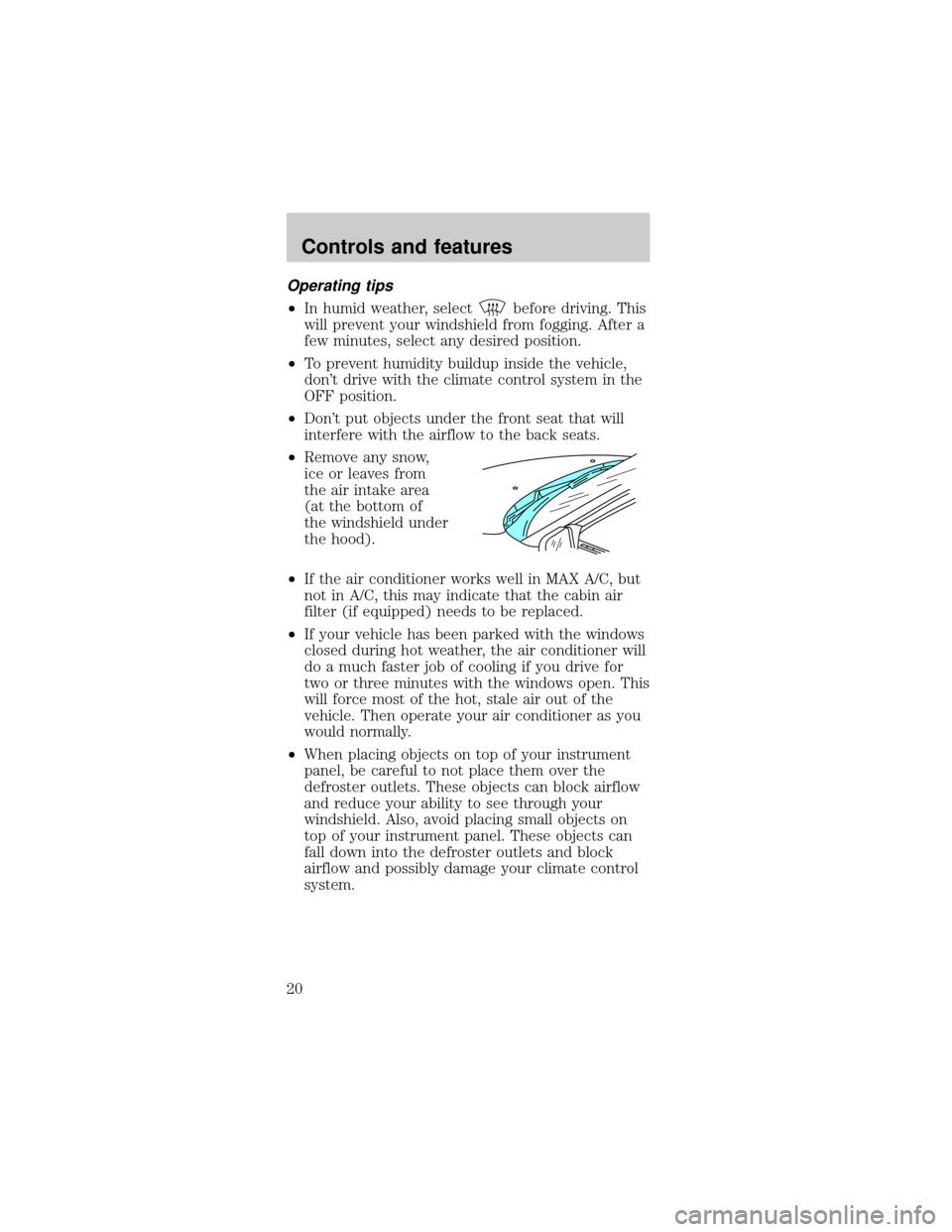climate control Mercury Sable 1998 Owner's Manuals
[x] Cancel search | Manufacturer: MERCURY, Model Year: 1998, Model line: Sable, Model: Mercury Sable 1998Pages: 190, PDF Size: 1.29 MB
Page 5 of 190

BASSTREBBALFADEREWFFEJECT
1234
56wTAPE SIDETAPE
R-DEFTUNESEEKSCAN AM
FM
MH
LO
HIOFF
A/C
MAX
A/CVENT
VOL
PUSH-ON
wSTFM 12
AMCBLRF
Climate
control
systems
(pg. 17)
Gearshift
(pg. 93) Electronic sound
system; refer to
Audio Guide
(pg. 27)Passenger
side air bag
(pg. 67)
Instrumentation
5
Page 17 of 190

²To turn autolamps off, rotate the control down
until it clicks.
REAR WINDOW DEFROSTER
Clears the rear window of thin ice and fog. To
operate:
1. Turn the ignition to the ON position.
2. Press and release
the control once to
turn on. The light will
be lit while the rear
window defroster is on.
3. Press and release the control again to turn off.
The defroster will automatically turn off after fifteen
minutes.
CLIMATE CONTROL SYSTEM
Manual heating and air conditioning system
(if equipped)
Fan speed control
Controls the volume of air circulated in the vehicle.
R-DEF
R-DEFLO
HIOFF
A/C
MAX
A/CVENT
LO
HI
Controls and features
17
Page 18 of 190

Temperature control knob
Controls the temperature of the airflow inside the
vehicle.
Mode selector control
Controls the direction
of the airflow to the
inside of the vehicle.
The air conditioning
compressor will operate in all modes except VENT
and
. However, the air conditioning will only
function if the outside temperature is about 10ÉC
(50ÉF) or above.
Since the air conditioner removes considerable
moisture from the air during operation, it is normal
if clear water drips on the ground under the air
conditioner drain while the system is working and
even after you have stopped the vehicle.
Under normal conditions, your vehicle's climate
control system should be left in any position other
than MAX A/C or OFF when the vehicle is parked.
This allows the vehicle to ªbreatheº through the
outside air inlet duct.
²MAX A/C-Uses recirculated air to cool the vehicle.
MAX A/C is noisier than A/C but more economical
and will cool the inside of the vehicle faster.
Airflow will be from the instrument panel
registers. This mode can also be used to prevent
undesirable odors from entering the vehicle.
²A/C-Uses outside air to cool the vehicle. It is
quieter than MAX A/C but not as economical.
Airflow will be from the instrument panel
registers.
²VENT-Distributes outside air through the
instrument panel registers. However, the air will
OFF
A/C
MAX
A/CVENT
Controls and features
18
Page 20 of 190

Operating tips
²In humid weather, selectbefore driving. This
will prevent your windshield from fogging. After a
few minutes, select any desired position.
²To prevent humidity buildup inside the vehicle,
don't drive with the climate control system in the
OFF position.
²Don't put objects under the front seat that will
interfere with the airflow to the back seats.
²Remove any snow,
ice or leaves from
the air intake area
(at the bottom of
the windshield under
the hood).
²If the air conditioner works well in MAX A/C, but
not in A/C, this may indicate that the cabin air
filter (if equipped) needs to be replaced.
²If your vehicle has been parked with the windows
closed during hot weather, the air conditioner will
do a much faster job of cooling if you drive for
two or three minutes with the windows open. This
will force most of the hot, stale air out of the
vehicle. Then operate your air conditioner as you
would normally.
²When placing objects on top of your instrument
panel, be careful to not place them over the
defroster outlets. These objects can block airflow
and reduce your ability to see through your
windshield. Also, avoid placing small objects on
top of your instrument panel. These objects can
fall down into the defroster outlets and block
airflow and possibly damage your climate control
system.
Controls and features
20
Page 24 of 190

The display will show
and a bar graph to
indicate manual fan
operation and relative
speed.
To return to automatic fan operation, press AUTO.
Manual override controls
The override controls are located at the bottom of
the EATC and allow you to determine where airflow
is directed. To return to full automatic control, press
AUTO.
The air conditioning compressor will operate in all
modes except
and VENT. It will also operate
only when required when AUTO has been selected.
However, the air conditioning will only function if
the outside temperature is about 10ÉC (50ÉF) or
above.
Since the air conditioner removes considerable
moisture from the air during operation, it is normal
if clear water drips on the ground under the air
conditioner drain while the system is working and
even after you have stopped the vehicle.
Under normal conditions, your vehicle's climate
control system should be left in any position other
than MAX A/C or OFF when the vehicle is parked.
This allows the vehicle to ªbreatheº through the
outside air inlet duct.
FAUTO
FAN• • •
TEMP
—+OFFAUTO
TEMPOUT
SIDEA/C MAXF-DEF
R-DEF
VENT
—+AUTOF
Controls and features
24
Page 26 of 190

²F- DEF-Distributes outside air through the
windshield defroster ducts. It can be used to clear
ice or fog from the windshield. If the outside air
temperature is about 10ÉC (50ÉF) or higher, the
air conditioner will automatically dehumidify the
air to prevent fogging.
²OFF-Outside air is shut out and the fan will not
operate. For short periods of time only, use this
mode to prevent undesirable odors from entering
the vehicle.
Displaying outside temperature
Press OUTSIDE TEMP
to display the outside
air temperature. It will
be displayed until
OUTSIDE TEMP is
pressed again or until
any other control is
pressed. When the
EATC system is off and OUTSIDE TEMP is pressed,
the outside temperature will only be displayed for
four seconds.
The outside temperature reading is most accurate
when the vehicle is moving. Higher readings may be
obtained when the vehicle is not moving. The
readings that you get may not agree with
temperatures given on the radio due to differences
in vehicle and station locations.
Operating tips
²In humid weather, select F-DEFbefore
driving. This will prevent your windshield from
fogging. After a few minutes, select any desired
position.
²To prevent humidity buildup inside the vehicle,
don't drive with the climate control system in the
OFF position.
²Don't put objects under the front seat that will
interfere with the airflow to the back seats.
OFFAUTO
TEMPOUT
SIDE
A/C MAX
VENT
Controls and features
26
Page 27 of 190

²Remove any snow,
ice or leaves from
the air intake area
(at the bottom of
the windshield).
²If your vehicle has been parked with the windows
closed during hot weather, the air conditioner will
do a much faster job of cooling if you drive for
two or three minutes with the windows open. This
will force most of the hot, stale air out of the
vehicle. Then operate the air conditioner as you
would normally.
²If the air conditioner works well in MAX A/C but
not in normal A/C, this may indicate that the
cabin air filter (if equipped) needs to be replaced.
²When placing objects on top of your instrument
panel, be careful to not place them over the
defroster outlets. These objects can block airflow
and reduce your ability to see through your
windshield. Also, avoid placing small objects on
top of your instrument panel. These objects can
fall down into the defroster outlets and block
airflow and possibly damage your climate control
system.
AUDIO SYSTEM
Refer to theAudio Guidefor instructions on how to
operate the audio system.
Controls and features
27
Page 149 of 190

about tire grades exactly as the government has
written it.
Treadwear
The treadwear grade is a comparative rating based
on the wear rate of the tire when tested under
controlled conditions on a specified government test
course. For example, a tire grade 150 would wear
one and one-half (1 1/2) times as well on the
government course as a tire grade 100. The relative
performance of tires depends upon the actual
conditions of their use, however, and may depart
significantly from the norm due to variations in
driving habits, service practices, and differences in
road characteristics and climate.
Traction A B C
The traction grades, from highest to lowest are A, B,
and C, and they represent the tire's ability to stop
on wet pavement as measured under test surfaces of
asphalt and concrete. A tire marked C may have
poor traction performance.
The traction grade assigned to this tire is
based on braking (straight ahead) traction
tests and does not include cornering (turning)
traction.
Maintenance and care
149